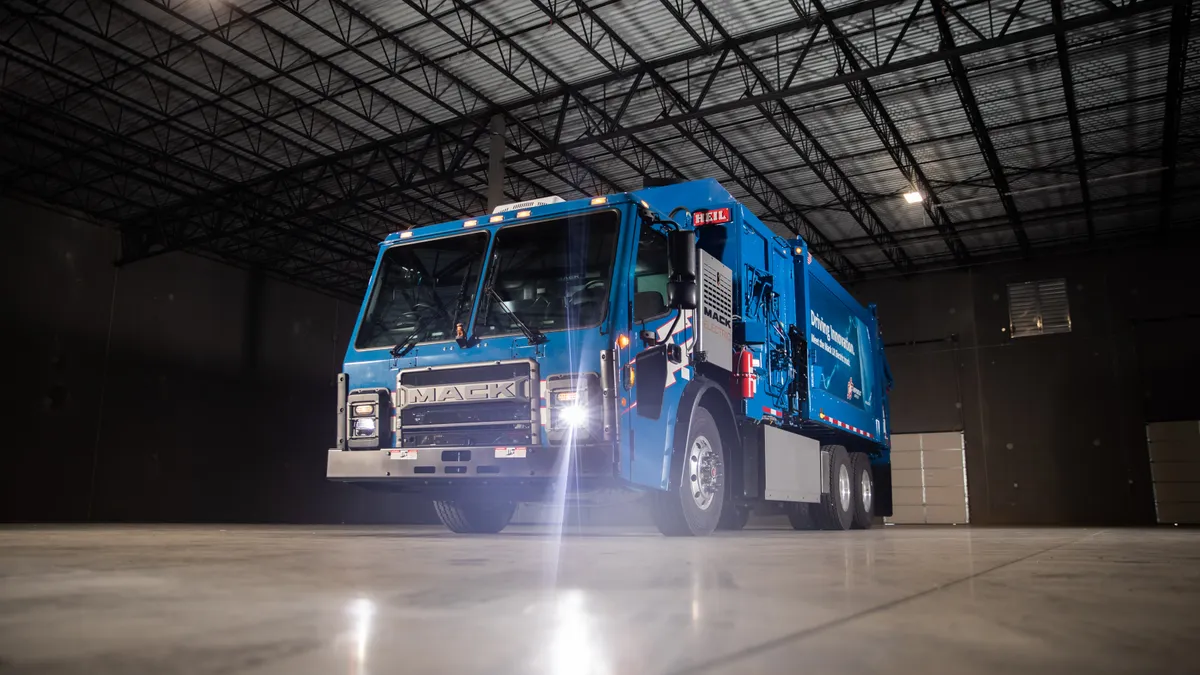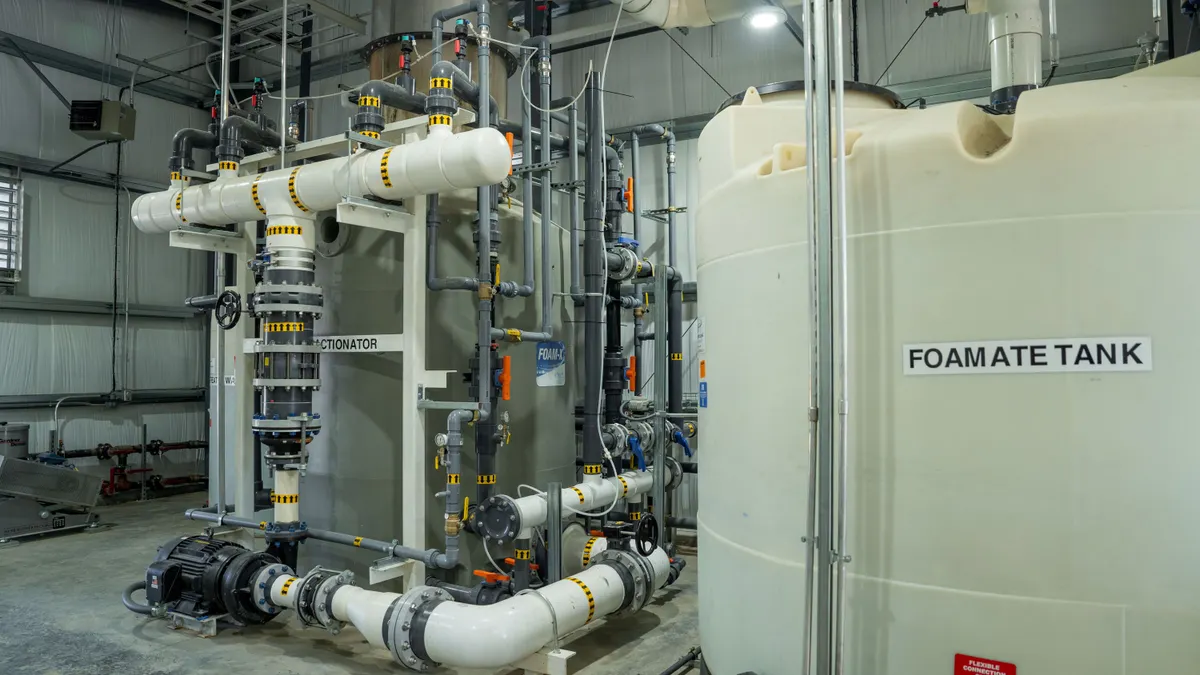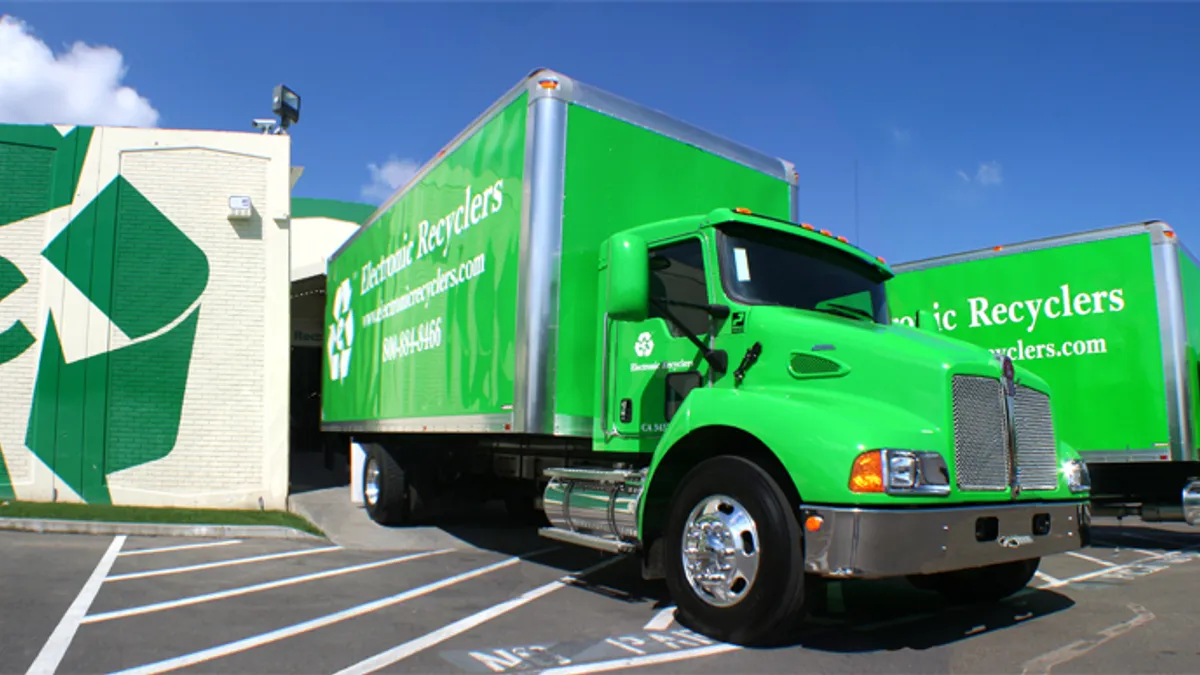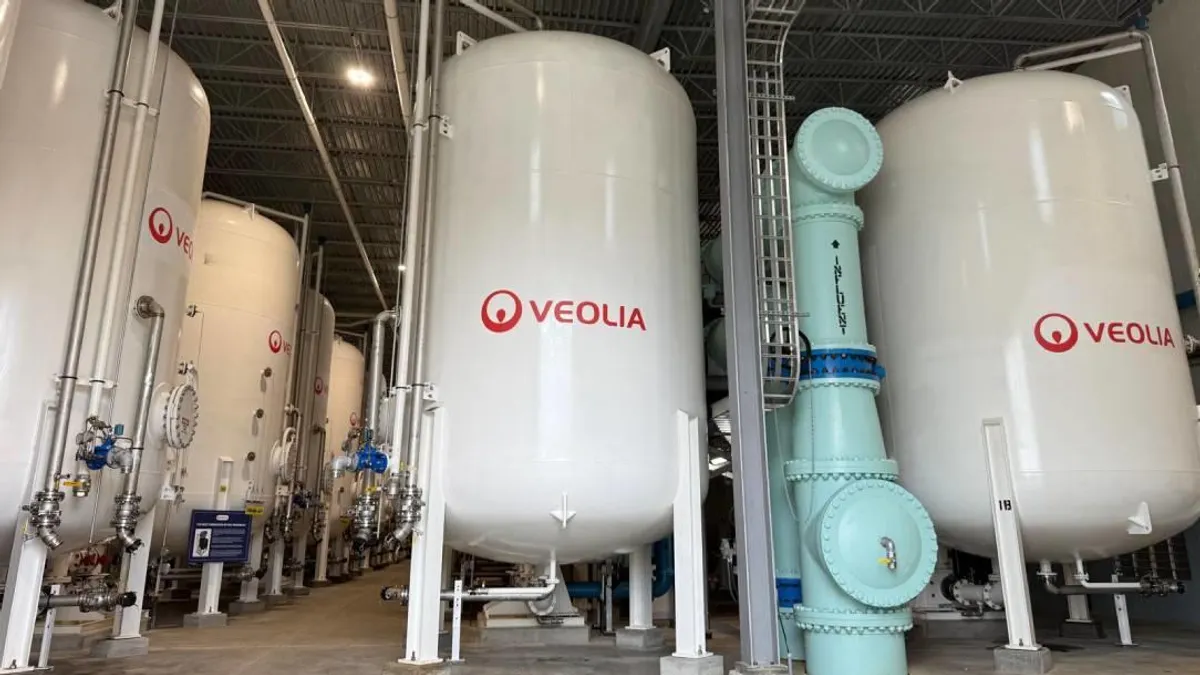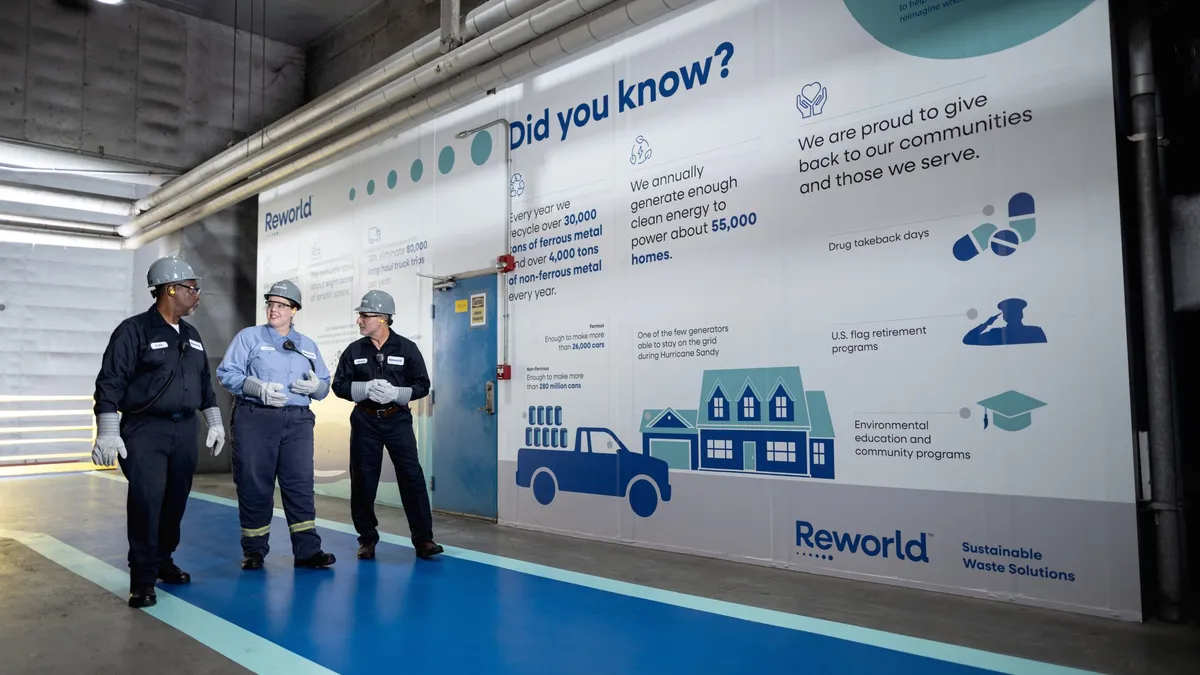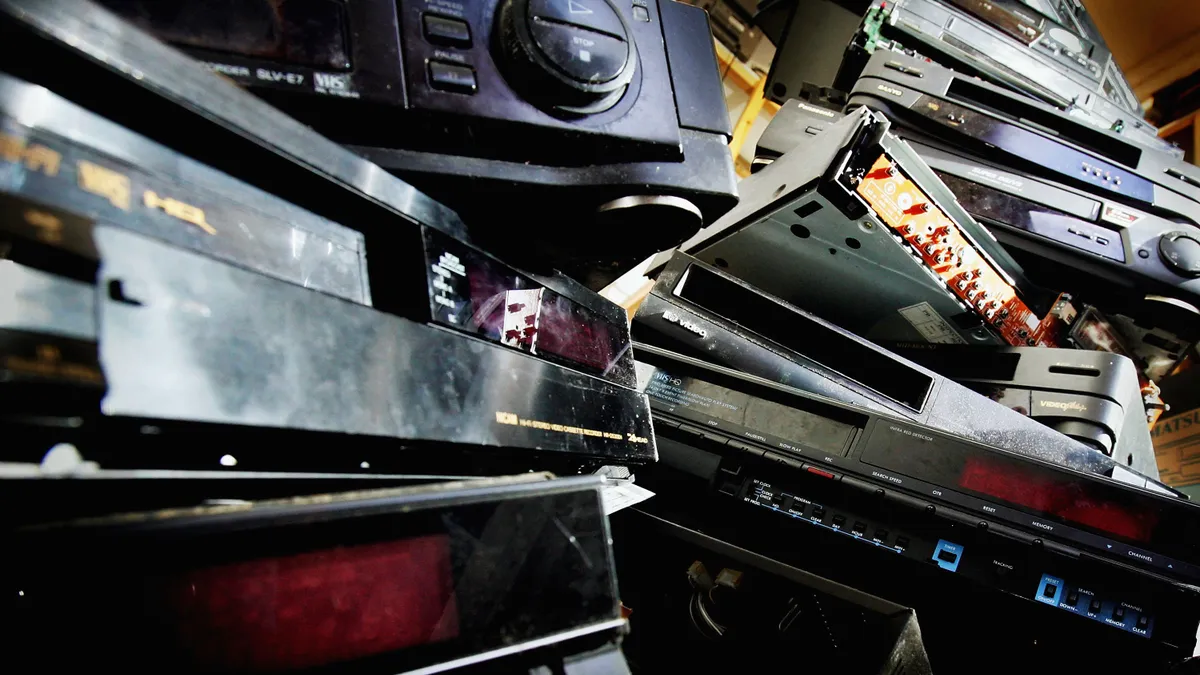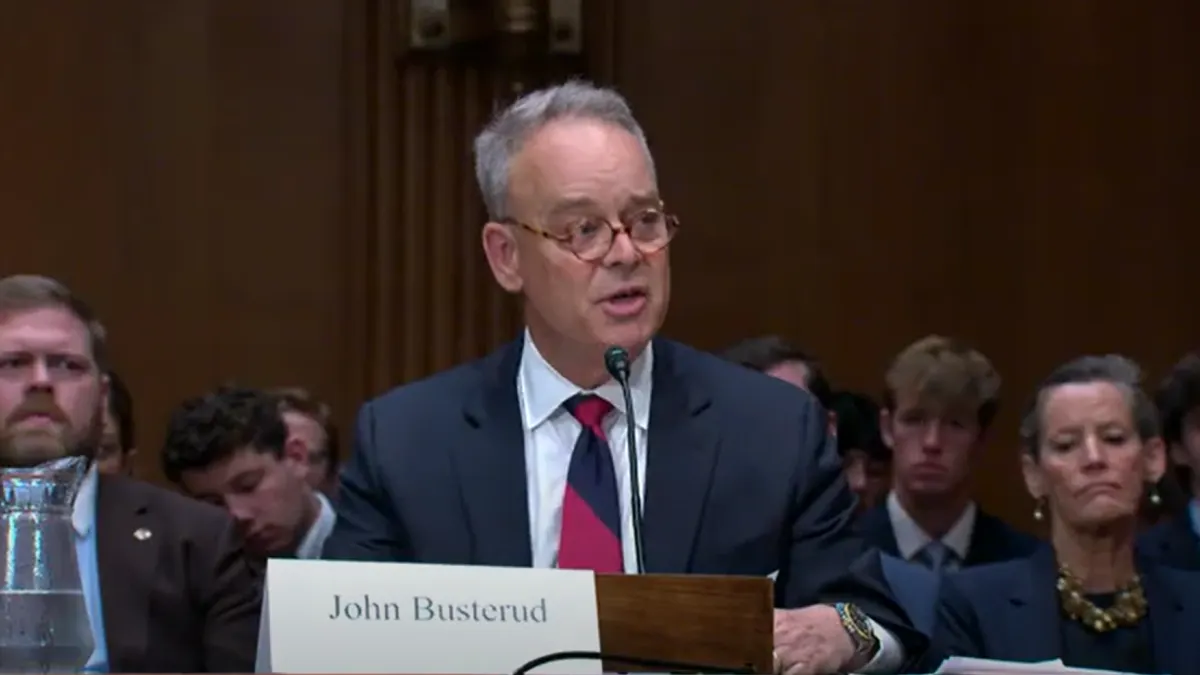This story is part of the Waste Dive Outlook on 2021, a series on the trends that will shape the industry in 2021. For a look at the business trends affecting other industries, see the Dive Outlook on 2021.
Local government budgets have been stretched and strained during the past year in previously unimaginable ways. Even with hundreds of billions of dollars in help potentially on the way to state and municipal operations, collection services are still expected to face worker absences and record levels of trash and recycling to manage.
The circumstances have required certain haulers and municipalities to at least temporarily change the services they offer. Still, some companies and governments are weighing imminent investments in new, customizable technologies aiming to make collection safer and more efficient, while lowering fleets’ environmental impact — one of the buzziest and most capital-intensive areas being around electric trucks.
In Baltimore for example, where citywide curbside recycling just restarted following a more than four-month hiatus, the pandemic ended up being the tipping point for acquiring logistics software from Rubicon. That nearly $792,000 investment via an emergency contract sets the city up to use the turn-by-turn route optimization product for a year, said Baltimore Department of Public Works’ John Chalmers, who heads the bureau of solid waste.
According to Rubicon, which has sold that software to more than 55 cities since 2017, the company had been in talks with Baltimore prior to COVID-19.
Yet, heightened worker absences due to illness or quarantine illuminated the challenge of how a manager or experienced driver being out could impede a crew's ability to run a typical route. Digitizing routes changes that in Baltimore's view. “When we get a new driver, that driver is going to hit the ground running,” Chalmers said.
The product suite is also meant to track missed pickups, which is considered especially critical as people stay home and produce higher-than-typical amounts of waste.
“The conversation really, because of the pandemic, I think accelerated. And we really started to get serious about talking about how we can help them on their operation, given all the challenges of the pandemic,” said Conor Riffle, Rubicon’s vice president of smart cities. The Baltimore contract aside, "overall, COVID has increased adoption of our technology."
Ultimately, Chalmers said, the city is interested in exploring other fleet and collection technologies but will see whether budgets allow.
Pressures to evolve
The pandemic, while pervasive, is a more temporary force for change than other regulatory and economic factors industry participants and observers alike believe will swell support for novel fleet and collection technologies.
Route optimization may be the lower-hanging fruit when it comes to making trucks more efficient on the road, and potentially reducing emissions as a result, but the vehicles themselves are also poised to change — eventually.
In Baltimore, a 2019 Sustainability Plan established a goal to drive citywide greenhouse gas emissions 30% below 2007 levels by 2023. On the opposite coast, Los Angeles committed to having a zero-emissions fleet by 2035, and the state of California has a mandate that all new vehicles sold in the state be electric by that same year. The list goes on — more loosely, Washington, D.C. is teaming with 15 states to ensure 30% of all new medium- and heavy-duty vehicle sales are zero-emission vehicles by 2030 (with an aim for that to reach 100% come 2050).
New York City is testing the waters with both partial and fully electric solutions for its more than 6,000-vehicle sanitation fleet. In the meantime, Canadian hybrid electric technology company Effenco retrofitted a dozen of its trucks to reduce engine use while idling and plans to do 14 more.
Effenco President David Arsenault views the disruptions felt during COVID-19 as a catalyst for change. "The waste industry is kind of a conservative industry," Arsenault said. "Most of our customers — the fact that they saw such a tiny virus having a tremendous impact on the life of everybody — now they're really thinking: what about climate change?"
Additionally, Mack Trucks, which says it currently has the largest share of DSNY's fleet, delivered an electric demo model to the department this past fall.
While some cities may not be moving as quickly on electrification, the better-capitalized private sector is being pushed along by environmental pressure from investors.
Over the past couple years, all publicly traded companies in the sector have set, or pledged to set, greenhouse gas emissions reduction targets, an important piece of environmental, social and corporate governance (ESG) goals. The nature of those emissions reduction targets differs by company, but regardless of the timing or how they're quantified, all are headed in the same direction and could approach those goals with the aid of at least partial fleet electrification or other investments in new technology.
Electrification on the horizon
Among those major companies, Republic Services has arguably been most out in front on embracing an electric future. President Jon Vander Ark this past year called the company "very bullish on electrification in the long term."
Still, Republic's industry-leading agreement with Nikola for up to 5,000 electrified refuse trucks, announced last August, came to an end in December. The companies cited "longer than expected development time, and unexpected costs."
Republic has said it's still very committed to pressing forward on electric options. Mack is one of those partners, and the team plans to test a jointly developed product early next year. Republic is also a key investor (and its chief operating officer is a member of the board of directors) at Romeo Electric Power, a recently public California company developing lithium-ion battery modules and packs for commercial electric vehicles.
"We look forward to working with all of our OEM partners to capitalize on innovative new technologies," the company said in a statement following the breakup with Nikola, adding that it's "planning to make additional purchases from various suppliers in 2021." Republic did not make a representative available to discuss the change further.
“You're seeing an increasing amount of competition, which is healthy and I think supports quality improvement," said Noah Kaye, a senior research analyst at Oppenheimer & Co.
Kaye cited existing industry partners such as Mack, Peterbilt and Lion all making plays in electric, but suggested it's still open season for vendors large and small, assuming they check the important boxes and are able to support a strong supply chain. "Waste companies shouldn't feel precluded from working with new entrants in the market."
One such company seeking to seize the moment is electric powertrain developer Wrightspeed, yet another California-based fleet tech hopeful.
"It's safe to say that everybody is talking to everybody right now," said Chairman Kevin Landis, noting interest from prospective partners.
In Landis' opinion, more influential than government or investor-driven climate actions are the declining costs associated with electric technologies.
"It's more about the economics than the politics," Landis said. "It's encouraging that the public dialogue [is good.] And that provides a source of pressure. But if the economics aren't there, then fleet operators will just do the minimum to check the box."
While Wrightspeed has previously tested its powertrains in the waste sector, it does not have any active pilots on the road. The company has had a number of leadership changes in recent years, including the departure of founder Ian Wright, a co-founder of Tesla.
By the company's own analysis, its diesel range-extended electric powertrain could save over $16,000 a year when compared to a heavy-duty residential garbage truck's fuel economy. Like other companies marketing collection technologies, there's a great emphasis on customization, with options for mid-life retrofitting, or potentially an entirely new electric truck.
But of Wrightspeed's offerings, the compressed natural gas (CNG) option continues to display the lowest total cost of ownership, according to company data. CNG, which is sometimes referred to as a "bridge technology" and does not reduce emissions as dramatically as electric, is also the method still favored by Waste Management and some others in the industry.
Another industry observer believes that while COVID-19 negatively affected local budgets, cities will always be cash-constrained in considering a big electrification transition.
"[M]any companies and municipalities are expected to 'wait-and-see' how early adopters benefit before moving forward with purchasing EVs themselves," said Camron Gorguinpour, director of mobility solutions at sustainability and energy consultancy ENGIE Impact, in an email.
"Overall the unknowns around infrastructure to support EVs, organizations' required fleet range and the cost of these vehicles will be the determining factors in the long-term success of the technology."
Largely, there's a lack of robust commitment so far from many of the major companies. Numerous executives have said electric trucks will be very important in the future, but are quick to name near-term barriers.
"This is an area where I think being a first mover is complex," said Casella Waste Systems Chief Financial Officer Ned Coletta, citing a lack of existing infrastructure and describing electric technologies as both very costly and still early in development. "There are other things that are here and now," Coletta added, giving a nod to route optimization tech as well as automated side load trucks that can more easily address some efficiency and GHG emission concerns in the short run.
Waste Connections, for its part, is beta testing a hybrid truck with a diesel chassis and fully electric body. "We just know that it's going to be a long haul, from beta testing to actual mass production of these vehicles," said Jim Little, executive vice president of engineering and disposal. " So in the interim, we still feel like RNG and CNG has a long way to play ... so we're focused on both ends of that — long term in the electric space and what those vehicles can do for us, and in the short term, building up our RNG capacity."
Meanwhile, compared to other major competitors, Waste Management's collection fleet leans most heavily on CNG (its collection fleet was over 70% CNG prior to finalizing its buyout of Advanced Disposal Services late in 2020) and intends to stick with it for sometime. Waste Management did not specify what the current rate of CNG trucks is since the integration of ADS.
CFO Devina Rankin cited expense and battery weight among the "limitations that prohibit us from seeing this as something that's a near-term solution." But Rankin said the company's fleet strategy would evolve as electric vehicles become "a more realistic and viable part of the solution."
Pitching during a pandemic
Despite the hesitation on the leap to electric, there are myriad other technologies that the industry is more comfortably adopting.
While waste and recycling software provider AMCS has seen some hesitation among prospective customers and a drop in new sales during the COVID-19 crisis, it has received more requests for help with route redesign due to the pandemic reshuffling the ratio between residential and municipal waste versus commercial and industrial volumes, according to Lasse Jiborn, commercial director of intelligent optimization.
On the need for route optimization, Jiborn said "the need has been there all along," but many customers "haven't really sensed the urgency" until the pandemic. It's the other trends that have been developing over the years, including falling costs of connected devices, that enabled those switches to be made relatively seamlessly for customers.
And like Rubicon's successful pitch in Baltimore, other collection technology specialists argue current cost constraints are the precise reason to start using new tools they pitch as paying for themselves.
San Diego-based company Lytx, which labels itself a video telematics specialist, has been around for more than two decades, in part selling 360-degree view dash cameras to fleets to promote safety and accountability.
When Kristin Costas, now director of product management, started at Lytx about nine years ago, a lot of effort went into getting customers comfortable with the idea of having cameras in the vehicle. "Collisions are very, very expensive, especially in the waste world," said Costas. Identifying and eliminating even just a "fraction" of risky behavior "really pays for our technology out of the gate."
In the last five years or so, Costas believes cameras have become ubiquitous. Waste Connections said it recently spent $10 million to replace earlier camera models, primarily through Lytx, though it also deploys cameras from Katy, Texas-based 3rd Eye "in markets where the product is best suited," according to emailed comments from Waste Connections Director of Finance Joe Box. "Overall, we are very excited with the new technology, which should help drive the next leg in improvement to safety." Despite cameras' proliferation in recent years, trash waste and recycling collection remains one of the deadliest occupations in the U.S.
Lytx's marketing still leads with safety, but has evolved to focus on potential cascading bottom-line benefits from safer driving, including using less fuel and putting less wear and tear on a vehicle, Costas said. The company has also dabbled in container tracking, an area San Francisco-based Compology has made its main focus.
Compology specializes in cameras that track contamination in containers, and how quickly they get full, thereby allowing a business to "right size" a pickup schedule. The idea is that the potential to reduce frequency of pickups may save customers money and cut down on unnecessary miles driven and therefore emissions.
According to Compology's findings from approximately 162,000 cameras, the average commercial container in the U.S. is only 46% full when it gets picked up to be emptied. "Now is the time, more than ever, to correct that," said Compology CEO Jason Gates.
Compology also sees opportunity in expanding its services into the newfound need for tracking, calculating and reporting progress on ESG goals as they become more commonplace. Over the long term, the company wants to build connections with back-office systems, and potentially serve as a hub between generators, haulers, and cities or state governments "that are all looking for the same pieces of information, but need it for different reasons."
Overall, Gates believes the businesses reaping the greatest benefits from these tools are those that can incorporate them early on, be they for container monitoring, in-cab routing technology, or customer interaction via chat bots.
As haulers seek help during turbulent times and anticipate future challenges, more are making the business case for that initial investment.
"Often the companies that are having the best return on using the technology are the ones who are able to design their business properties around actually using that technology from day one."
Correction: A previous version of this story misrepresented Compology's findings on container fullness. Based on data from 162,000 cameras, the average container in the U.S. is 46% full at pickup time.



